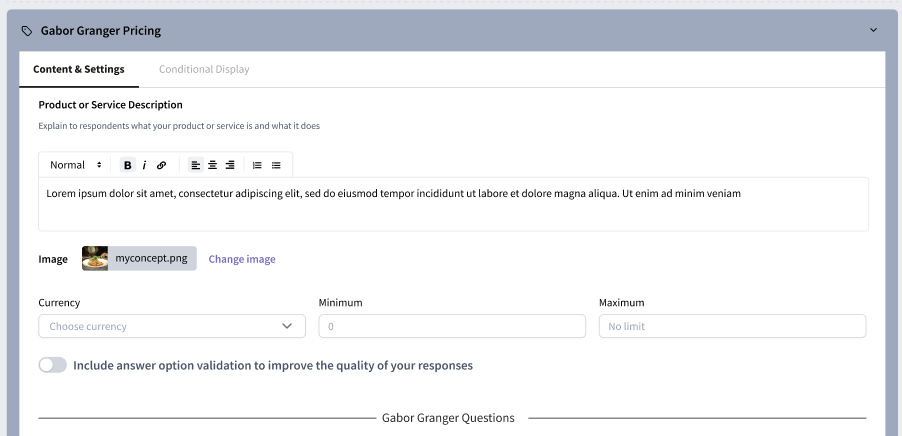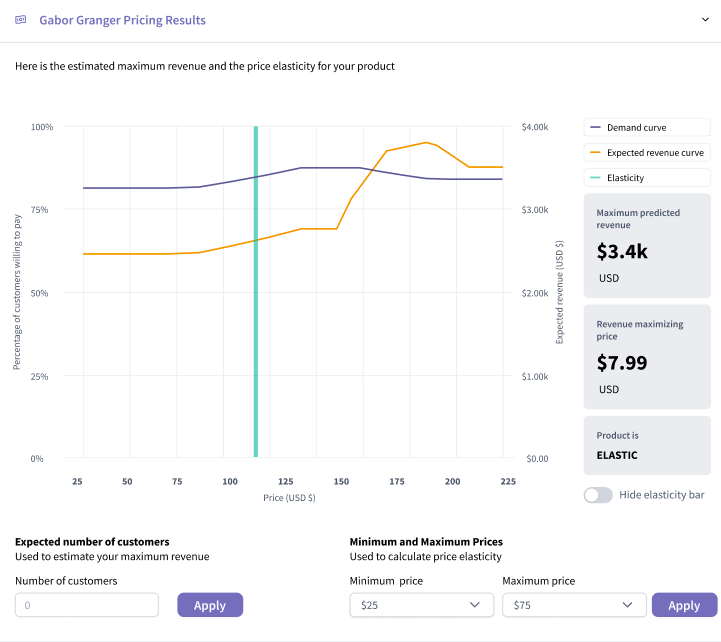Have you ever wondered how companies determine the price of their products or services?
It’s a crucial decision that can make or break a business. But without solid data on what consumers are willing to pay, choosing a price point for any product is just a shot in the dark.
That’s where the Gabor-Granger pricing methodology comes into play.
Today, we'll explore the ins and outs of the Gabor-Granger methodology and how to use it in your market research to find the optimal price point for your offering.
What is Gabor-Granger?
Gabor-Granger is a pricing methodology used in market research to examine the relationship between price and demand for products and services. While it will ultimately help you find the optimal price point, it will also show you the effect that raising or lowering your price will have on your product’s demand.
It does this by giving respondents a series of nearly identical questions, the base of which being: “Would you buy [PRODUCT] for $[PRICE]?”
Once the first question is posed to respondents, the subsequent questions are adapted to their answers. Presenting respondents with higher prices, until they indicate a lack of purchase intent. Ultimately, these questions are designed to determine the highest price a consumer is willing to pay.
Based on the responses, a demand curve is generated, showing the relationship between price and demand and highlighting an optimal price point that maximizes revenue.
While there are many pricing methodologies to choose from, we would suggest choosing Gabor Granger if:
 You have an established price range but need to pinpoint an exact price. (If you need to establish a price range, we'd suggest using a Van Westendorp.)
You have an established price range but need to pinpoint an exact price. (If you need to establish a price range, we'd suggest using a Van Westendorp.)
 You want to understand the price sensitivity surrounding your product or category.
You want to understand the price sensitivity surrounding your product or category.
 You need to understand the role price will play in the demand for your product.
You need to understand the role price will play in the demand for your product.
Gabor-Granger with SightX
With SightX, finding the price point that maximizes your revenue is simple.
After creating a new project, you’ll start in the BUILD section. There you can select “Gabor-Granger Pricing” from the add item menu.

The experiment will immediately populate, giving you space to add a description and image of your product or service. You can also set a currency and minimum and maximum prices if you have them.

Below that, you’ll find the experiment. The first question you’ll see is an optional purchase intent screener. This question allows you to disqualify respondents who have no intent to purchase your product. While optional, we would suggest leaving this toggled. From there, you’ll see the price questions, where you can edit the intervals and labels.
Once your data is collected, you'll see something similar to the graph below. The purple line shows your demand curve, while the yellow line shows your expected revenue. To the right of the graph, you'll see your revenue maximizing price displayed.

You can also add your expected number of customers to estimate your maximum revenue, and change the prices you’d like to test to determine if a price is elastic or inelastic.
Optimize Your Pricing Strategy with SightX
If you’re ready to level up your insights, we’ve got the tools to make it happen!
The SightX platform is the next generation of market research tools: a single unified solution for consumer engagement, understanding, advanced analysis, and reporting.
But, SightX isn’t just great tech. Our Research Services team knows all of the best practices, along with some tips and tricks for getting the best data out of your surveys and experiments.
Remove the guesswork from your strategy by going directly to the source. Get started today!